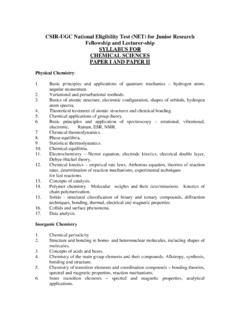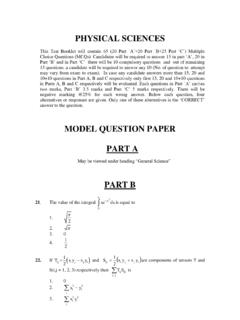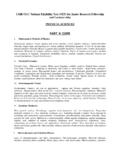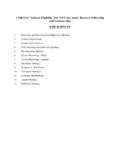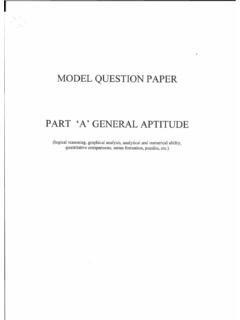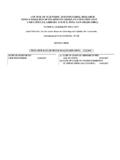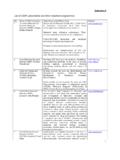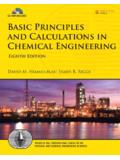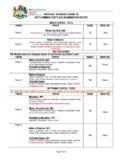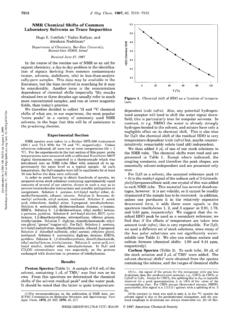Transcription of PART A - csirhrdg.res.in
1 chemical sciences This Test Booklet will contain 120 (20 part A + 40 part B + 60 part C ) Multiple Choice Questions (MCQs). Candidates will be required to answer 15 in part A , 35 in part B and 25 questions in P arts C r espective ly (No. of question to a ttempt may v ary from exam to exam). In case any candidate answers more than 15, 35 and 25 questions in Parts A, B and C respective ly only first 15, 35 and 25 questions in Parts A, B and C respective ly will be eva lua ted. Questions in Parts A and B carry two marks each and part C questions carry four marks each. There will be ne gative marking @ 25% for each wrong answer. Below each question, four alternative s or r esponses a re given.
2 Only one o f these a lternative s is the CORRECT answer to the question. MODEL QUESTION PAPER part A May be viewed under heading General Science part B 21. [CoCl4]2-shows a deep blue colour because of 1. metal t o ligand charge t ransfer transition 2. ligand to metal charge t ransfer transition 3. spin allowed and Laporte f or bidden d-d transition 4. spin allowed and Laporte a llowed d-d transition 22. The violet colour of iodine vapour is due to 1. t ransition 2. t ransition 3. t ransition 4. t ransition 23. Choose the cor rect statement among the following 1. diamond has lower thermal and electrical conductivities compared to graphite 2. diamond has similar thermal and electrical conductivities compared to graphite 3.
3 Diamond has higher thermal conductivity but lower electrical conductivity compared to graphite 4. diamond has the same thermal but lower e lectri cal conductivity c ompared to graphite 24. Which of the following i s a nido- borane? 1. B4H10 2. B5H9 3. [B6H6]2- 4. B5H11 25. Among the three t ype s of orbital sp, d, and f, 1. both p and f orbitals have centre o f s ymmetry 2. both p and d orbitals have centre of symmetry 3. only d orbitals have centre of symmetry 4. f orbitals alone have centre of symmetry 26. The a bsorbance o f solution having 20% tr ansmittanc e is 1. 2. 3. 4. 27. The active si te of e nz yme nitrogenise c ontains 1. Mo 2. Mn 3. Fe 4. Cu 28. Which one of the f ollowing is a free r adical?
4 1. CO 2. CN 3. NO 4. CS 29. Choose the 16 e complex f rom the following: 1. Ni(CO)4 2. Rh(PPh3)3Cl 3. Fe(CO)5 4. ( 6-C6H6)2Cr 30. The species having metal-metal bond is: 1. Mn2(CO)10 2. Al2(CH3)6 3. V2(CO)12 4. Al2(OPri)12 31. The only molecule having bridging oxyge n is 1. Phosphorus trioxide 2. Phosphorus pentoxide 3. Cyclic tetraphosphate 4. Pyrophosphate 32. The c oordination number of phosphorus in [PMo12O40]3- is 1. 2 2. 4 3. 5 4. 6 33. Using phenolphthalein as the indicator, which of the following titration is possible: 1. acetic acid with pyridine 2. oxalic acid with sodium hydroxide 3. hydrochloric acid with aniline 4. sulphuric acid with aqueous ammonia 34. Which of the following s pecies is ESR-active ?
5 1. VOSO4 2. K2Cr2O7 3. KMnO4 4. [Co(NH3)6]Cl3 35. Large d evi ation from Trouton's rule is observed for s ystems which a re 1. ha ving more ordered structure 2. ha ving more disordered structure 3. ha ving low melting points 4. ha ving low boiling points 36. The c oncentration of a reactant decreases linearly with time. Wha t i s the orde r of the reaction? [A] t 1. 1st or de r 2. Fractional order 3. 2nd or de r 4. Zero order 37. The point g roup symmetry of the molecule cis ML4X2 is 1. C4v 2. D4h 3. C2h 4. C2v 38. The number of rotational degrees of f reedom of CO2 is 1. one 2. two 3. three 4. four 39. The magnitude of the nuclear spin angul ar momentum of a nuclei is 15/2 units.
6 The value of 1 is 1. 5/2 2. 1/2 3. 1 4. 3/2 40. Which of the following t ransitions in the electronic spectrum of a homonuclear diatomic molecule is forbidden 1. + + 2. + 3. + 4. + 41. The diffraction pattern of a c ubic solid has an intense 110 Bragg r eflection, but the 100 and 111 Bragg reflections are absent. The structure of the solid is 1. Body-centered cubic 2. Primitive c ubic 3. Face-centered cubic 4. Edge-centered cubic 42. The logarithmic c onductivity of a crystalline solid shows a l inear variation with inverse temperature (1/T). The b and gap may b e o btained from 1. slope of the plot. 2. intercept on the c onductivity a xis. 3. intercept on the temperatur e a xis.
7 4. inverse slope 43. The molar masses of monodisperse and polydisperse polymers obey respectively the conditions: ( = Number average molecular weight and = Weight average molecular weight). 1. > and < 2. = and < 3. < and < 4. = and = 44. The spatial part of hydrogen molecular wave function in the simplest molecular orbital the or y is given by 2 where is a normalized linear combina tion of two hydr ogen 1s or bitals. Which of the following is true about the a bove wave func tion? 1. It contains only c ovalent terms. 2. It i nc ludes only a small amount of ionic terms. 3. It contains only ionic t erms.
8 4. It over estimates the ionic te rms. 45. A 2pz or bital of hydrogen atom is an eigenfunction of 1. H only. 2. H and L2 only 3. H, L2 and Lz only 4. H, L2, Lz and Lx 46. By a reve rsible process, we mean one that always 1. takes infinite time f or c ompletion 2. satisfi es S (universe) = 0 3. satisfi es G = 0. 4. gives the minimum work 47. A hydrogenic 3p orbital ha s the following form of the radial wavefunc tion ( i= constant): 1. ( 1 ) 2 2. 3 3. ( 4 )( 5 ) 6 4. 3 3 48. IUPAC name f or t he c ompound given below is OO 1. E-5- ethylhept-5- en- 2- one 2. Z-5- ethylhept -5- en-2- one 3. E-3- ethylhept-2- en- 6- one 4. Z-3- ethylhept -2- en-6- one 49.
9 The most suitable reagent for the following transfor mation is MeOMeOO 1. NaBH4 2. B2H6 3. Zn- Hg/ HCl 4. NH2NH2/ HCl 50. The major product formed in the reaction of 2-methyl but-3- en-2- ol with HBr is 51. Among dimethylcyclobutanes, which one can exhibit optical activity? 1. cis-1,2-dimethylcyclobutane 2. trans-1,2-dimethylcyclobutane 3. cis-1,3-dimethylcyclobutane 4. trans-1,3-dimethylcyclobutane 52. The monomer of biopolymer D NA is a 1. nucleotide 2. aminoacid 3. disaccharide 4. fatty acid 53. The order of chemical shifts ( value) in the1H NMR spectrum of crotonalde hyde is 1. olefinic>CHO>Me 2. CHO>Me>olefinic 3. CHO>olefinic>Me 4. olefinic>Me>CHO 54. The product formed in the reaction given below is 55.
10 The major product formed in the reaction given below is +MeCOOMe 56. The c onversion of e xcited singlet state (S1) of a molecule to triplet state (T1) is known as 1. fluorescence 2. phosphorescence 3. intersystem crossing 4. internal conversion 57. The decreasing orde r of stability o f the f ree r adicals A, B a nd C is MeMeMeMeMeHCH2 HMeMeHHACB 1. A >B >C 2. C >A >B 3. B>A>C 4. A >C >B 58. The major product formed in the reaction given below: OHHNaN3?? 59. The rates of keto-enol t automerism in the ketones A-C, given below are in the order OAOBCO 1. A >B >C 2. A >C >B 3. C >A >B 4. C >B>A 60. The reaction given below is an example of COOEtCOOEtOCOOEtNaOEt Volumetric method for Ag(I) Indicator used (a).
